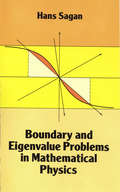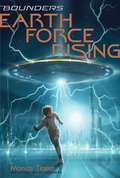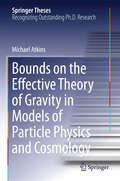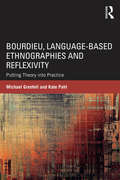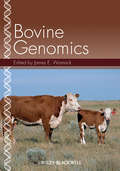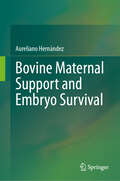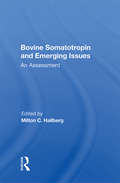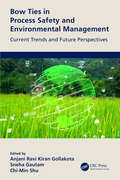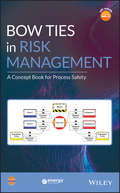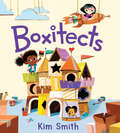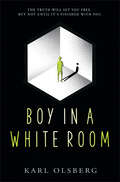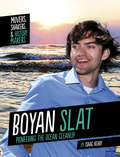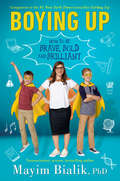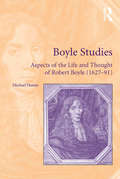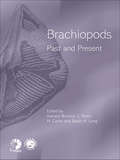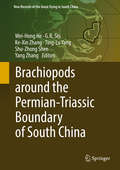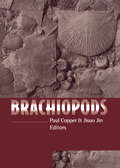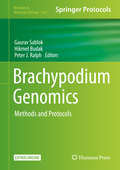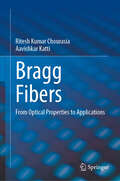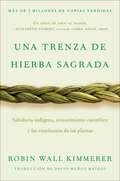- Table View
- List View
Boundary and Eigenvalue Problems in Mathematical Physics
by Hans SaganThis well-known text uses a limited number of basic concepts and techniques — Hamilton's principle, the theory of the first variation and Bernoulli's separation method — to develop complete solutions to linear boundary value problems associated with second order partial differential equations such as the problems of the vibrating string, the vibrating membrane, and heat conduction. It is directed to advanced undergraduate and beginning graduate students in mathematics, applied mathematics, physics, and engineering who have completed a course in advanced calculus. In the first three chapters, Professor Sagan introduces Hamilton's principle and the theory of the first variation; he then discusses the representation of the vibrating string, the vibrating membrane and heat conduction (without convection) by partial differential equations. Bernoulli's separation method and infinite series solutions of homogeneous boundary value problems are introduced as a means for solving these problems. The next three chapters take up Fourier series, self-adjoint boundary value problems, Legendre polynomials, and Bessel functions. The concluding three chapters address the characterization of eigenvalues by a variational principle; spherical harmonics, and the solution of the Schroedinger equation for the hydrogen atom; and the nonhomogeneous boundary value problem. Professor Sagan concludes most sections of this excellent text with selected problems (solutions provided for even-numbered problems) to reinforce the reader's grasp of the theories and techniques presented.
Bounders
by Monica TeslerIn the tradition of Michael Vey and The Unwanteds, twelve-year-old Jasper and his friends are forced to go up against an alien society in this first book in a brand-new adventure series!Thirteen years ago, Earth Force--a space-military agency--discovered a connection between brain structure and space travel. Now they've brought together the first team of cadets, called Bounders, to be trained as high-level astronauts. Twelve-year-old Jasper is part of this team being sent out into space. After being bullied back on Earth, Jasper is thrilled to have something new and different to do with other kids who are more like him. While learning all about the new technologies and taking classes in mobility--otherwise known as flying with jetpacks--Jasper befriends the four other students in his pod and finally feels like he has found his place in the world. But then Jasper and his new friends learn that they haven't been told everything about Earth Force. They weren't brought to space for astronaut training, but to learn a new, highly classified brain-sync technology that allows them to manipulate matter and quantum bound, or teleport. And it isn't long before they find out this new technology was actually stolen from an alien society. When Jasper and his friends discover the truth about why Earth Force needs them, they are faced with a choice: rebel against the academy that brought them together, or fulfill their duty and protect the planet at all costs.
Bounds on the Effective Theory of Gravity in Models of Particle Physics and Cosmology (Springer Theses)
by Michael AtkinsThe effective theory of quantum gravity coupled to models of particle physics is being probed by cutting edge experiments in both high energy physics (searches for extra dimensions) and cosmology (testing models of inflation). This thesis derives new bounds that may be placed on these models both theoretically and experimentally. In models of extra dimensions, the internal consistency of the theories at high energies are investigated via perturbative unitarity bounds. Similarly it is shown that recent models of Higgs inflation suffer from a breakdown of perturbative unitarity during the inflationary period. In addition, the thesis uses the latest LHC data to derive the first ever experimental bound on the size of the Higgs boson's non-minimal coupling to gravity.
Bourdieu, Language-based Ethnographies and Reflexivity: Putting Theory into Practice
by Kate Pahl Michael GrenfellOffering a unique and original perspective on Bourdieu, language-based ethnographies,and reflexivity, this volume provides a nuanced, in-depth discussion of the complex relationship between these interconnected topics and their impact in real-world contexts. Part I opens the book with an overview of the historical background and development of language-based ethnographic research and Bourdieu’s work in this space. Part II presents a series of case studies that highlight a Bourdieusian perspective and demonstrate how reflexivity impacts language-based ethnography. In each study, Bourdieu’s conceptual framework of reflexively-informed objectivity examines the ways in which the studies themselves were constructed and understood. Building on Parts I and II, the concluding set of chapters in Part III unpacks the messiness of the theory and practice of language-based ethnography, and provides insights into what reflexivity means for Bourdieu and in practical contexts. Arguing for a greater reflexive understanding in research practice, this volume sets an agenda for future literacy and language research.
Bovine Genomics
by James E. WomackThe genetic information being unlocked by advances in genomic and high throughput technologies is rapidly revolutionizing our understanding of developmental processes in bovine species. This information is allowing researchers unprecedented insight into the genetic basis of key traits. Bovine Genomics is the first book to bring together and synthesize the information learned through the bovine genome sequencing project and look at its practical application to cattle and dairy production. Bovine Genomics opens with foundational chapters on the domestication of cattle and traditional Mendelian genetics. Building on these chapters, coverage rapidly moves to quantitative genetics and the advances of whole genome technologies. Significant coverage is given to such topics as epigenetics, mapping quantitative trail loci, genome-wide association studies and genomic selection in cattle breeding. The book is a valuable synthesis of the field written by a global team of leading researchers. Providing wide-ranging coverage of the topic, Bovine Genomic, is an essential guide to the field. The basic and applied science will be of use to researchers, breeders, and advanced students.
Bovine Maternal Support and Embryo Survival
by Aureliano HernándezIn this work, the endocrine and histological preparations of the uterine environment for embryo/foetus survival are covered, through compilation of relevant research results pertaining ovarian, uterine and placental changes. Also, a general overview of the ovarian cycle, uterine changes, development of the placenta, nutritional and immunological mechanisms of embryo acceptance and protection, as well as some of the most outstanding causes of embryo/foetus mortality. Each chapter involves a general discussion of relevant and pertinent research findings, including already accepted facts and those which open the possibility of new research directions. Synthesis of possible mechanisms of main biological phenomena are illustrated. More than 400 references were taken into account and herein presented, as well as photographs and illustrations.
Bovine Somatotropin And Emerging Issues: An Assessment
by Milton C HallbergBovine somatotropin, or bST, a growth hormone genetically engineered to increase milk production in dairy cows, highlights the controversial issues of biotechnology and its widespread use. Focusing on the problems inherent in new and radically different technologies, this book develops a methodology for examining bST and other biotechnological deve
Bow Ties in Process Safety and Environmental Management: Current Trends and Future Perspectives
by Chi-Min Shu Sneha Gautam Anjani Ravi Kiran GollakotaBow Ties in Process Safety and Environmental Management: Current Trends and Future Perspectives aims to combine the process safety aspects and the potential dangers to the ecology including the source of the contamination, and especially, the unbalanced utilization of toxic chemicals in process industries. It also covers a broad spectrum of industrial process safety, environmental pollution factors, dangers to land, water, air and living species, remediation technologies (traditional and futuristic approaches), pollutant degradation through numerical modelling, and physicochemical characteristics of the chemicals and their thermal analysis. It also provides the mandated safety data sheets already available and suggestions for the improvement of industrial specifications. Discusses detailed aspects of process safety and environmental impact from a theoretical and practical perspective Covers detailed procedures of environmental modeling concepts Explores forensic investigation sequences during the incident Proposes futuristic approaches towards risk assessment and management Includes real-time case studies with complexities and solutions This book is written for researchers, graduate students, and professionals involved in Chemical Engineering, Environmental Engineering, and Process Safety Engineering.
Bow Ties in Risk Management: A Concept Book for Process Safety
by CcpsFrom a collaborative effort of the Center for Chemical Process Safety (CCPS) and the Energy Institute (EI) comes an invaluable book that puts the focus on a specific qualitative risk management methodology – bow tie barrier analysis. The book contains practical advice for conducting an effective bow tie analysis and offers guidance for creating bow tie diagrams for process safety and risk management. Bow Ties in Risk Management clearly shows how bow tie analysis and diagrams fit into an overall process safety and risk management framework. Implementing the methods outlined in this book will improve the quality of bow tie analysis and bow tie diagrams across an organization and the industry.
Box Turtles and Other Pond and Marsh Turtles (World Book's Animals of the World)
by Christina JohnsonIntroduces the box turtle and talks about keeping one as a pet.
Boxitects
by Kim SmithA STEAM-centered, adorably illustrated picture book about Meg, a brilliant and creative boxitect who creates extraordinary things out of ordinary cardboard boxes.Meg is a brilliant and creative boxitect. She loves impressing her teacher and classmates with what she makes out of boxes.But there’s a new kid at Maker School: Simone. Simone is good at everything, and worst of all, she’s a boxitect too.When the annual Maker Match is held, Meg and Simone are paired as a team but can’t seem to stop arguing. When their extraordinary project turns into a huge disaster, they must find a way to join creative forces, lift each other up, and work together.
Boy Were We Wrong About Dinosaurs!
by Kathleen V. KudlinskiThe ancient Chinese thought they were magical dragons. Some old-time scientists thought that because they were so big, all they could do was float in water. Boy, were they wrong! Even today, once-common notions about dinosaurs are being revised as new discoveries are made. This lively book about the perennially popular subject of dinosaurs offers fascinating insight into how certain theories were formed, and then how those theories were proved or disproved. It demonstrates that scientific thought is as creative as it is logical and invites budding scientists to come up with their own ideas. This book offers a lively account of theories from the past about dinosaurs and how these theories changed as new discoveries were made.
Boy in a White Room
by Karl OlsbergA gripping YA sci-fi thriller by German and Spiegel-bestselling author, Karl Olsberg. The Boy in a White Room was nominated for Deutscher Jugendliteraturpreis 2018, Germany’s most prestigious youth fiction award.A fifteen-year-old boy wakes to find himself locked in a white, cube-shaped room. No windows. No doors. Total silence. He has no memories. No clue how he got there. No idea who he is.A computer-generated voice named Alice responds to his questions. Through her, he is able to access the internet. As the boy uncovers snippets of his story -- an attempted abduction, a critial injury, a murder -- it becomes clearer. But when some of the pieces don't fit, how can he tell what's real and what's not? Who can he trust? And who is he really?
Boy, Were We Wrong About the Human Body!
by Kathleen V. KudlinskiLong, long ago, ancient Egyptians thought that all of our ideas and personalities came from our hearts—boy, were they wrong!Debunking old (and sometimes silly) myths about the human body, this new addition to the Boy, Were We Wrong series shows how we discovered modern biology and medicine. From healing by applying leeches, to the ancient practice of acupuncture, to the discovery and study of DNA, this is the story of what we know about our bodies and how we still have lots to learn.A perfect selection for Common Core or STEM collections
Boy, Were We Wrong About the Solar System!
by Kathleen V. Kudlinski John RoccoSome people used to think that Earth was smack-dab in the middle of the universe, with all the stars and planets held in the sky by giant glass balls. Boy, were they wrong! In this follow-up to the award-winning Boy, Were We Wrong About Dinosaurs!, Kathleen Kudlinski and John Rocco look at the mistakes, mishaps, and creativity that are part of scientific discovery. From the first humans wondering about the night sky to the demotion of Pluto to dwarf planet status, this book is an entertaining and informative look at how scientific theories change over time.
Boy, Were We Wrong About the Weather!
by Kathleen V. KudlinskiHurricaines, Thunder and Lightning, climate change, Wind, Rain. We were once wrong about all of these. But are we right now? Find out in the latest book in this award-winning series. Ancient Sumerian warriors used to think that lightning and thunder were caused by an angry weather god —boy, were they wrong! Even today once common ideas about how our weather and climate work are changing as new discoveries are being made. Kathleen V. Kudlinski and Sebastià Serra team up to debunk old—and sometimes silly—myths about weather and to celebrate the pioneers that made meteorology the science it is today. This award-winning series is especially meant for the budding scientist and is perfect for children who are fascinated by the natural world and how it works.
Boyan Slat: Pioneering the Ocean Cleanup (Movers, Shakers, and History Makers)
by Isaac KerryDutch student Boyan Slat always loved inventing. A visit to the oceans of Greece inspired his greatest invention ever. Why were there more plastic bags than fish? How could he save the sea? Learn more about Boyan’s Great Pacific Garbage Patch project; The Ocean Cleanup and his plastic cleanup invention, System 001; and the challenges behind removing trash from our oceans and rivers.
Boying Up: How to Be Brave, Bold and Brilliant
by Mayim BialikMayim Bialik, star of The Big Bang Theory and author of the #1 bestseller Girling Up, puts her Ph.D. to work to talk to teen boys about the science and pressures of growing up male in today's world. A must-have book for all teenage boys! <P><P>Why does my voice crack like that? What should I eat to build muscle? How do I talk to someone I have a crush on? What do I do if someone calls me names or bullies me?Growing from a boy to a man is no easy task. <P>Bodies are changing, social circles are evolving, hair is appearing in places it never was before -- and on top of it all, there's the ever-present pressure to conform to the typical idea of what it means to be "manly" and masculine. But it's easier to do if you're armed with facts. <P>Using personal anecdotes as an overly observant mother of two boys and plenty of scientific information from her life as a neuroscientist, Mayim Bialik, PhD, star of The Big Bang Theory, talks directly to teen boys about what it means to grow from a boy to a man biologically, psychologically, and sociologically. <P>Using the same cool, fun, and friendly tone that she took in Girling Up, Mayim takes boys--and their parents!--through the challenges and triumphs of Boying Up today. <P>In six sections (How Boys Bodies Work; How Boys Grow; How Boys Learn; How Boys Cope; How Boys Love; and How Boys Make a Difference), she takes a look at what it means for boys to come of age in today's world, how can they take control of their paths, and what can they do to help shape the types of futures they want for themselves. <P><b>A New York Times Bestseller</b>
Boyle Studies: Aspects of the Life and Thought of Robert Boyle (1627-91)
by Michael HunterThe significance of Robert Boyle (1627-91) as the most influential English scientist in the generation before Newton is now generally acknowledged, but the complexity and eclecticism of his ideas has also become increasingly apparent. This volume presents an important group of studies of Boyle by Michael Hunter, the leading expert on Boyle’s life and thought. It forms a sequel to two previous books: Hunter’s Robert Boyle: Scrupulosity and Science (2000) and The Boyle Papers: Understanding the Manuscripts of Robert Boyle (2007). Like them, it conveniently brings together material otherwise widely scattered in essay volumes and academic journals, while nearly a third of the book’s content is hitherto unpublished. The collection opens with a substantial introduction that places the studies that follow in the context of existing studies of Boyle; appended to it is an annotated edition of Boyle’s telling list of desiderata for science. The next three essays comprise a group of essentially biographical studies, exploring various aspects of Boyle’s life and intellectual evolution, after which three others provide further evidence of the ’convoluted’ Boyle divulged in Robert Boyle: Scrupulosity and Science. Finally, we have two chapters, one hitherto published only in French and the other not at all, which throw important light on topics that preoccupied Boyle in the last few years of his life - the supernatural and the exotic. Together, these essays add greater depth to our understanding of Boyle, both as an individual and as a natural philosopher.
Brachiopods (Systematics Association Special Volumes Ser.)
by Howard Brunton L. Robin M. Cocks Sarah M. LongThe growth history of a brachiopod is entombed in its shell, but research on fossil and living brachiopods has generated unanswered questions about these marine invertebrates. Several contributors to Brachiopods Past and Present comment on their differing structures and morphological detail. They use these as examples of ontogenetic and evolutionar
Brachiopods around the Permian-Triassic Boundary of South China (New Records Of The Great Dying In South China Ser.)
by Yang Zhang Wei-Hong He G. R. Shi Ke-Xin Zhang Ting-Lu Yang Shu-Zhong ShenBrachiopods: The O/s Extinction Recovery Fauna (Special Papers In Palaeontology Ser. #No. 74)
by Paul CopperThis collection of conference papers presents information on the molecular genetics, biomineralization, growth and ecology of extant brachiopod stocks (extrapolated back to the Cambrian), and the shell microstructure, taphonomy, paleogeography, evolution, and taxonomy of fossil brachiopods.
Brachypodium Genomics: Methods and Protocols (Methods in Molecular Biology #1667)
by Hikmet Budak Gaurav Sablok Peter J. RalphThis volume presents protocols for Brachypodium genomics in numerous areas ranging from marker development, trait evolution, functional genomics, metabolomics, transcriptomics, genomics, and tilling. This book also explores techniques to study the widening genetic base of Brachypodium that will help researchers better understand the model plant using NGS technologies. Written in the highly successful Methods in Molecular Biology series format, chapters include introductions to their respective topics, lists of the necessary materials and reagents, step-by-step, readily reproducible laboratory protocols, and tips on troubleshooting and avoiding known pitfalls. Cutting-edge and comprehensive, Brachypodium Genomics: Methods and Protocols is a valuable resource for bench-oriented molecular biologists and computational biologists working towards further evolving this field.
Bragg Fibers: From Optical Properties to Applications
by Aavishkar Katti Ritesh Kumar ChourasiaThis book highlights the guiding mechanisms as well as the most current and important results in the field of innovative, bio-inspired Bragg fibers. While conventional optical fibers (COF) have several advantages over traditional waveguides, they also suffer from a number of disadvantages which are not present in Bragg fibers due to their minimal nonlinearities, lack of polarization or birefringence effect, lack of Fresnel reflections at the open fiber end, and absence of material or cladding losses. A natural platform for biological and chemical sensing, and with potential to boost communication systems' speed and bandwidth, the primary goal of this book is to apprise readers in academia and industry of properties of EM wave propagation in Bragg fibers with a defect layer. Their major applications in bio/chemical sensing, fuel adulteration sensing, high-temperature sensing, optical dual-channel inline filtering, optical de-multiplexers, optical couplers, and nonlinear soliton generation are presented in detail, along with comparisons of Bragg fibers with alternative structures and their relative pros and cons.
Braiding Sweetgrass / Una trenza de hierba sagrada (Spanish edition): Sabiduría indígena, conocimiento científico y las enseñanzas de las plantas
by Robin Wall KimmererUno de los libros más importantes de nuestros tiempos, que nos invita a descubrir un nuevo lenguaje para comunicarnos con la naturaleza y recibir sus enseñanzas. Como mujer indígena, Robin Wall Kimmerer es heredera de un valioso legado que considera a los animales y las plantas nuestros mejores maestros. Como botánica, se ha valido del rigor científico para estudiar mejor la naturaleza. Y como madre, profesora y escritora, ha dedicado su vida a conjugar ambas perspectivas para abogar por un despertar de la consciencia ecológica que reconozca y celebre nuestra profunda conexión con otras formas de vida.En Una trenza de hierba sagrada, la autora entreteje experiencias y saberes en una serie de relatos iluminadores y emotivos que nos inspiran a fortalecer nuestra relación sagrada con la Madre Tierra. Cada capítulo es una magnífica lección de gratitud y reciprocidad, que nos recuerda que, si ofrecemos nuestros dones al mundo y lo ayudamos a sanar, este nos retribuirá con la armonía y el bienestar que tanto anhelamos.Bestseller del New York TimesBestseller del Washington PostBestseller del Los Angeles Times«Mejor Colección de Ensayos de la Década» según Literary Hub———A masterpiece of our times, inviting us to discover a new language for communicating with nature and receiving its lessons.As a Native American woman, Robin Wall Kimmerer is the heir to a valuable legacy that views animals and plants as our greatest and oldest teachers. As a botanist, she leverages scientific knowledge to better understand nature. And as a mother, teacher, and writer, she has dedicated her life to blending these perspectives and advocate for an awakening of ecological consciousness that acknowledges and celebrates our deep connection with other forms of life.In Braiding Sweetgrass, the author weaves together experiences and knowledge in a series of illuminating and emotional stories that inspire us to reinvigorate our sacred relationship with Mother Earth. Each chapter offers a magnificent lesson in gratitude and reciprocity, reminding us that if we contribute our gifts to the world and help it heal, it will reward us with the harmony and wellness we are yearning for.A New York Times BestsellerA Washington Post BestsellerA Los Angeles Times BestsellerNamed a “Best Essay Collection of the Decade” by Literary Hub
